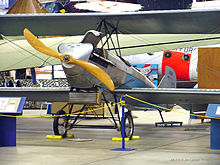Scimitar propeller
This articleneeds additional citations forverification.(December 2009) |



Ascimitar propelleris a type ofpropellerthat has curved blades with increasingsweepalong the leading edge. Their name is derived from their visual similarity to the curved blades ofscimitars.In the early 1900s, as established by the French aeronautical inventorLucien Chauvièreand his commercial success with his scimitar-shapedIntegralepropeller design,[1]they were made of laminated wood. The combination of light weight and efficient aerodynamics results in more power and reduced noise.[citation needed]
All propellers lose efficiency at highrotational speedsdue to an effect known aswave drag,which occurs as anairfoilapproachessupersonicspeeds. This powerful form ofdragreduces propeller efficiency at high rotational speed which, in turn, reduces power transmission from the aircraft's engine.[2]In the case of a propeller, this effect can happen when the propeller turns fast enough that the tips of the blades approach the speed of sound, even if the plane itself is not moving forward. Wave drag also occurs at high linear aircraft speeds.[2]According to the same principles that governswept wingsin high-speed aircraft, propeller blades can be swept back in order to mitigate wave drag, thus allowing them to remain efficient at higher rotational speeds. Since the inboard part of a propeller has a slower rotational velocity relative to the tip, the blade becomes progressively more swept from the propeller hub to the tip, giving rise to its characteristic shape.
In the 1940s,NACAstarted researching swept propellers for use in high-speed propeller-driven aircraft.[3]Modern usage of scimitar propellers centers aroundturbopropandpropfanengines. Since these forms of propulsion are capable of driving a propeller at transsonic or supersonic rotational speeds, as well as propelling aircraft to similarly high speeds, mitigation of wave drag is an important consideration in achieving high aerodynamic efficiency. Like modern straight-bladed propellers, scimitar propellers often make use of lightweight materials to further increase efficiency.
Propfan engines were intended to deliver significant improvements infuel economycompared to contemporary turbofan engines, and in this they succeeded. In static and air tests on a modifiedDC-9,propfans reached a 30% improvement.[citation needed]This efficiency comes at a price, as one of the major problems with the propfan isnoise,particularly in an era where aircraft are required to comply with increasingly strictEASAandFAAnoise requirements for certification. Propfans often feature scimitar blades as they typically operate at high rotational speeds.
References
[edit]- ^Gibbs-Smith, C.H. (2003).Aviation.London: NMSO. p. 150.ISBN1-9007-4752-9.
- ^abGudmundsson, Snorri (2022).General Aviation Aircraft Design(Second ed.). Butterworth-Heinemann. p. 597-656.doi:10.1016/B978-0-12-818465-3.00015-X.ISBN978-0-12-818465-3.S2CID245971692.
- ^Whitcombe, Richard (May 4, 1950).A description of the design of highly swept propeller blades.Langley Aeronautical Laboratory.
